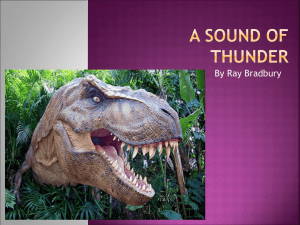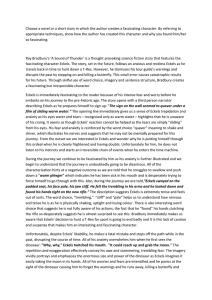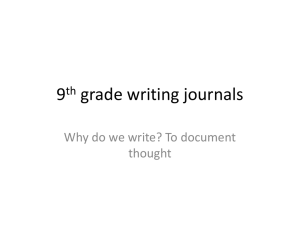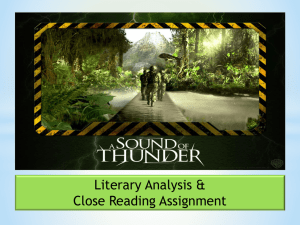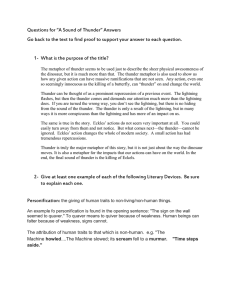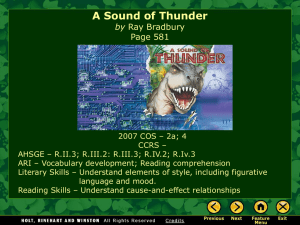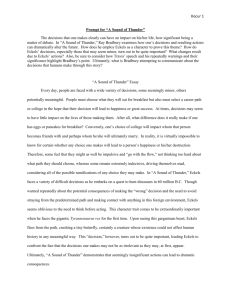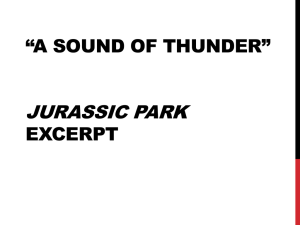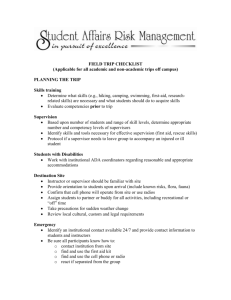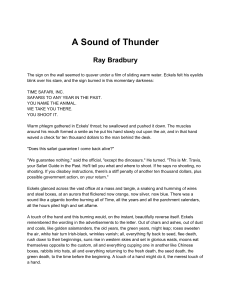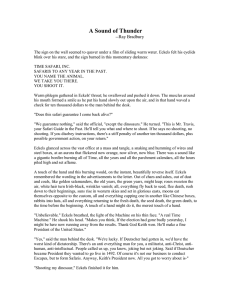Sound of Thunder - Berkeley County Schools
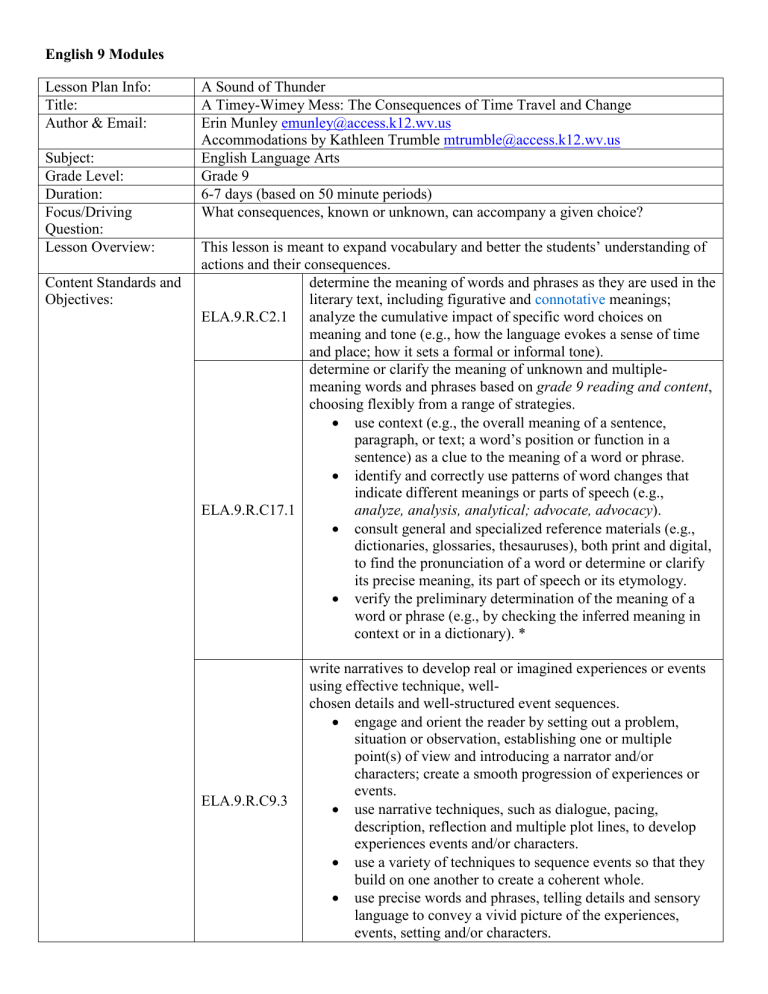
English 9 Modules
Lesson Plan Info:
Title:
Author & Email:
Subject:
Grade Level:
Duration:
Focus/Driving
Question:
Lesson Overview:
A Sound of Thunder
A Timey-Wimey Mess: The Consequences of Time Travel and Change
Erin Munley emunley@access.k12.wv.us
Accommodations by Kathleen Trumble mtrumble@access.k12.wv.us
English Language Arts
Grade 9
6-7 days (based on 50 minute periods)
What consequences, known or unknown, can accompany a given choice?
Content Standards and
Objectives:
This lesson is meant to expand vocabulary and better the students’ understanding of actions and their consequences.
ELA.9.R.C2.1 determine the meaning of words and phrases as they are used in the literary text, including figurative and connotative meanings; analyze the cumulative impact of specific word choices on meaning and tone (e.g., how the language evokes a sense of time and place; how it sets a formal or informal tone). determine or clarify the meaning of unknown and multiplemeaning words and phrases based on grade 9 reading and content , choosing flexibly from a range of strategies.
use context (e.g., the overall meaning of a sentence, paragraph, or text; a word’s position or function in a sentence) as a clue to the meaning of a word or phrase.
identify and correctly use patterns of word changes that indicate different meanings or parts of speech (e.g.,
ELA.9.R.C17.1 analyze, analysis, analytical; advocate, advocacy ).
consult general and specialized reference materials (e.g., dictionaries, glossaries, thesauruses), both print and digital, to find the pronunciation of a word or determine or clarify its precise meaning, its part of speech or its etymology.
verify the preliminary determination of the meaning of a word or phrase (e.g., by checking the inferred meaning in context or in a dictionary). * write narratives to develop real or imagined experiences or events using effective technique, well- chosen details and well-structured event sequences.
engage and orient the reader by setting out a problem, situation or observation, establishing one or multiple point(s) of view and introducing a narrator and/or characters; create a smooth progression of experiences or
ELA.9.R.C9.3 events.
use narrative techniques, such as dialogue, pacing, description, reflection and multiple plot lines, to develop experiences events and/or characters.
use a variety of techniques to sequence events so that they build on one another to create a coherent whole.
use precise words and phrases, telling details and sensory language to convey a vivid picture of the experiences, events, setting and/or characters.
ELA.9.L.C15.1
provide a conclusion that follows from and reflects on what is experienced, observed or resolved over the course of the narrative.
demonstrate command of the conventions of standard
English grammar and usage when writing or speaking.
use parallel structure.
use various types of phrases (noun, verb, adjectival, participial, prepositional, absolute) and clauses (independent, dependent; noun, relative, adverbial) to convey specific meanings and add variety and interest to writing or presentations.
21 st
Century Learning
Skills and Technology
Tools:
Teacher Facilitation for
Student Acquisition of
Background
Knowledge:
Anchor Texts &
Questions for Close
Reading:
Vocabulary
Development:
N/A
Teacher will introduce the vocabulary words identified by the textbook to the students. Students will take the given definitions for the vocabulary words and put them into their own words on the given flashcard sheets.
“A Sound of Thunder” by Ray Bradbury
Students will be given new vocabulary words verbally by the instructor. The teacher will provide a worksheet of word association flashcards for the students to cut out and complete. In their own words, the students will copy a definition for each given word into each box of the worksheet. On the other side of each card, students should create a drawing to represent each word.
Words from textbook: Annihilate, expendable, depression, paradox, delirium, resilient, remit, revoke, primeval, subliminal
Managing the Lesson: Day 1: Vocabulary
Teacher will pass out flashcard worksheet to students. Students will define each of the vocabulary words on the worksheet and give each word’s part of speech.
Students will cut apart the words to use as flash cards. On the reverse side of the flash card, the student should create a picture to represent each vocabulary word.
Students would then compose a short essay correctly utilizing all of the vocabulary that answers the following prompt: “You have been given a working time machine that can travel to any location in time and space. Where would you go? Who would you meet? What would you do?”
Accommodation: Visual aid creation to increase memory. As students complete flashcards, call students attention to word cues in the definition that signal part of speech.
Day 2: Cause and Effect
Teacher will introduce cause and effect to the students. Using a graphic organizer, have students come up with two events or decisions that have been made in their own lives; these should be put into the boxes under effect. Then have the student
Active Literacy:
Post Literacy: identify the cause for these two events or decision (link in materials section).
Instructor will then show clips/an episode from the series Doctor Who ; Suggested episodes include, but are not limited to, the following: “Fathers Day” from Series 1
(2005)**, “Blink” from Series 3 (2007), “The Wasp and the Unicorn” from Series 4
(2008), “The Pandorica Opens” from Series 5 (2010)**, and/or “Angels Take
Manhattan” from Series 7 (2012). While watching, students should be identifying instances of cause and effect within the episodes in the remaining boxes of their worksheet. Episodes should be chosen by the instructor ahead of time based on the comprehension level of the students.
** “Father’s Day” and “The Pandorica Opens” can also be used to further the understanding of paradox because the characters exist more than once in the same location at the same time. There are consequences with this existence that will enhance the understanding of time travel in the novel.
Accommodation: Provide (prompt) students with examples of effects.
Day 3-4: Reading “Sound of Thunder”
As the students read through the story, they should be completing Skeleton Notes
(attached). The notes will act as framework for the story and is based upon knowledge that the student will need for the assessment at the end of the unit.
Students will fill in the blanks with the appropriate information from the text.
Accommodation: Instructor will utilize an audio version of the story (CD with textbook). Intermittently, the instructor will stop the audio and lead the students through the questions that have been covered in that section of reading. The instructor will assist the students in achieving the correct answers through verbal guided questioning and volunteers. Completed skeleton notes will also be made available to readers to compare correct answers with their own independently.
Day 5 (and 6, if necessary): Review
Before the lesson, the instructor should create index cards containing questions or vocabulary usage situations that could potentially appear on the assessment for the short story. The cards should be separated into equal groupings, either randomly or by category (number of groupings should be based on class size and number of questions)
Accommodation: Struggling students may defer to another student as long as they repeat the correct answer.
Day 6 (or 7): Assessment
Students will complete a formal assessment that covers key elements and information covered during preliminary activities and/or the reading of the short story. The instructor may use the test that accompanies the textbook or create an assessment of his/her own.
Accommodation: Provide oral testing and clarification of directions to struggling readers.
Students will complete skeleton notes as they read in order to assert understanding and comprehension.
Students will work in groups to assert understanding and correct information that
Product/Performance: Students will create visual flashcards to help enhance memorization and recall.
Students will also complete skeleton notes that will act as a study guide for the assessment.
Reflection: may be incorrect, misunderstood, or missing in order to increase comprehension and prepare for an assessment.
Reteach cause and effect to struggling individuals and connect it to other readings that have been completed.
Materials & Resources: Textbook for vocabulary definitions
(Elements of Literature, Third Course)
Worksheet containing vocabulary words
Worksheet for cause and effect
( http://www.educationoasis.com/curriculum/GO/GO_pdf/causeeffect_chart.pdf
)
Colored pencils, crayons, and/or markers
Laptop with internet access
Projector
Video clips of Doctor Who
Websites:
YouTube ( http://www.youtube.com
)
Amazon ( http://www.amazon.com/s/ref=nb_sb_ss_c_0_10?url=search-alias%3Dinstantvideo&field-keywords=doctor%20who&sprefix=doctor+who%2Caps%2C341 ) iTunes
Skeleton Notes Worksheet
Listed with materials
Career Connection: Reading strategies: word association for memory recall, reading from a textbook for a profession
Narrative writing: storytelling and communication skills that can be used as a connecting point in the workplace
Files Uploaded:
Date Created:
Date Modified:
Key Word Search
Fields:
N/A
March 26, 2013
May 28, 2013
Sound of Thunder, vocabulary, narrative writing
Annihilation
Part of Speech: __________
Definition: ______________
_______________________
_______________________
_______________________
Expendable
Part of Speech: __________
Definition: ______________
_______________________
_______________________
_______________________
Depression
Part of Speech: __________
Definition: _____________
_______________________
_______________________
_______________________
Paradox
Part of Speech: __________
Definition: _____________
_______________________
_______________________
_______________________
Delirium
Part of Speech: __________
Definition: ______________
_______________________
_______________________
_______________________
Resilient
Part of Speech: __________
Definition: ______________
_______________________
_______________________
_______________________
Remit
Part of Speech: __________
Definition: _____________
______________________
______________________
______________________
Revoke
Part of Speech: __________
Definition: _____________
_______________________
_______________________
_______________________
Primeval
Part of Speech: __________
Definition: ______________
_______________________
_______________________
_______________________
___________________
Part of Speech: __________
Definition: ______________
_______________________
_______________________
_______________________
Subliminal
Part of Speech: __________
Definition: ______________
_______________________
_______________________
_______________________
___________________
Part of Speech: __________
Definition: ______________
_______________________
_______________________
_______________________
__________________
Part of Speech: __________
Definition: _____________
_______________________
_______________________
_______________________
__________________
Part of Speech: __________
Definition: _____________
_______________________
_______________________
_______________________
__________________
Part of Speech: __________
Definition: _____________
_______________________
_______________________
_______________________
__________________
Part of Speech: __________
Definition: _____________
_______________________
_______________________
_______________________
Name______________________________________ Period __________ Date ______________________
“A Sound of Thunder” by Ray Bradbury
Skeleton Notes
Vocabulary annihilate, expendable, depression, paradox, delirium, resilient, remit, revoke, primeval, subliminal
Plot
1.
_______________ is the protagonist of this story. At the opening of the tale, he has arrived at _______________, a company that specializes in _______________________________.
2.
Some words that describe _______________ would be as follows: ____________________________,
__________________________, and ___________________________.
3.
______________________ doesn’t guarantee that clients will __________________________, but it does guarantee ______________________.
4.
______________________ is the guide on this excursion to ______________________.
5.
The first rule ______________________ gives for the trip is “________________________________________.”
The penalty for violating this rule is ______________________________________________________________.
6.
The discussion of ___________________ between Travis and Eckels is an example of _____________________.
7.
The two candidates in the resent election were ______________________ and ______________________.
8.
The hunters will be traveling to __________________________. He is given the option to __________________ before they make the trip back in the machine.
9.
Eckels plans to shoot a _________________________________.
10.
The people in the time machine with Eckels are __________________________, the Safari Guide;
_________________________, his assistant; _________________________, a fellow hunter; and
______________________, another hunter.
11.
The second rule of the trip is to ______________________________________, which hovers six inches above the ground. They must follow this rule so that _______________________________________________.
12.
They cannot change anything about their surroundings except what they are specifically there to kill because it will trigger_______________________________, meaning that ______________________________________
___________________________________________________________________________________________.
13.
______________________ went back in time before the trip to be sure that _____________________________
________________________________________________________.
14.
______________________ studied the ______________________________ for _______________________ until it met its end by ____________________________________________.
15.
They trail the men are to follow is marked by ____________________________. The beast they are hunting has been marked with a ___________________________.
16.
The travelers won’t run into themselves in the past because __________________________________________.
It creates a _______________________________.
17.
When the dinosaur finally appears, Eckels ______________________. ______________________ tells him to go____________________________________, but he ends up _______________________________________.
The following inference can be made about Eckels based on his actions: ________________________________
___________________________________________________________________________________.
18.
After the dinosaur was killed, ______________________ and ______________________ threw up. The group found ______________________ in the ______________________. ______________________ wants to leave
______________________ in the past, but ________________________________________________________.
19.
______________________ forced Eckels to _____________________________________ from the
_____________________. He must do this because ________________________________________________.
20.
The significance of the years mentioned in the return trip is as follows: a.
1492 b.
1776 c.
1812
21.
When the group returns to their present, things are very different: ______________________ is the president, the ______________________ has changed, and the setting is now ______________________.
22.
All of the changes to their present were caused by __________________________________________________.
23.
At the end of the story, we can infer than _________________________________________________________.
“A Sound of Thunder” by Ray Bradbury
Skeleton Notes
KEY
Vocabulary annihilate, expendable, depression, paradox, delirium, resilient, remit, revoke, primeval, subliminal
Plot
1.
__ Eckels ___________ is the protagonist of this story. At the opening of the tale, he has arrived at
_ Time Safari Inc.
_, a company that specializes in ___ safaris in the past _________.
2.
Some words that describe __ Eckels ________ would be as follows: ____ rich _______,
___ arrogant __________, and ____ shallow __________.
3.
__ Time Safari
__________ doesn’t guarantee that clients will _______ survive ___________, but it does guarantee ____ the animals (dinosaurs) _____.
4.
___ Travis _______ is the guide on this excursion to __ Jurassic Period/past/60 million years ____.
5.
The first rule ___ Time Safari Inc.
__ gives for the trip is “______ don’t shoot unless given permission ______.”
The penalty for violating this rule is __ $10,000 and government action ______________.
6.
The discussion of __ the election ____ between Travis and Eckels is an example of __ foreshadowing ____.
7.
The two candidates in the resent election were ____ Keith ________ and ___ Deutscher ________.
8.
The hunters will be traveling to __ 60 million years ago __. He is given the option to __ leave with their money __ before they make the trip back in the machine.
9.
Eckels plans to shoot a ___ Tyrannosaurus rex __________.
10.
The people in the time machine with Eckels are ____ Travis ___________________, the Safari Guide;
__ Lesperance __, his assistant; __ Billings ___________, a fellow hunter; and _____ Kramer _________, another hunter.
11.
The second rule of the trip is to ___ not step off the metal path ___________, which hovers six inches above the ground. They must follow this rule so that ____ they don’t kill anything important _________________.
12.
They cannot change anything about their surroundings except what they are specifically there to kill because it will trigger__ Butterfly/Ripple/Domino Effect ___, meaning that _____ one small action will ripple and magnify over time with catastrophic results ______________________________________________________.
13.
___ Lesperance ______ went back in time before the trip to be sure that ___ they wouldn’t change the future because of something they did in the past (i.e. kill an animal) __________________.
14.
___ Lesperance _______ studied the ___ Tyrannosaurus rex _______________ for ____ its entire existence ____ until it met its end by ___ a tree falling on it ____________.
15.
They trail the men are to follow is marked by __ a raised path _______________. The beast they are hunting has been marked with a ___ a red paint bomb ______.
16.
The travelers won’t run into themselves in the past because _____ time won’t allow them to do so ___________.
It creates a ___ paradox __________.
17.
When the dinosaur finally appears, Eckels ___ panics _________. _____ Travis ___________ tells him to go____ back to the time machine ______, but he ends up ___ running off the path into the jungle ___________.
The following inference can be made about Eckels based on his actions: ________________________________
_______ he is going to change the future because he ran off the path __________________.
18.
After the dinosaur was killed, __ Billings ______________ and ____ Kramer ______________ threw up. The group found ___ Eckels _______________ in the ___ time machine _______. ___ Travis ______________ wants to leave
____ Eckels _________ in the past, but ___ Lesperance stops him because he could alter the past further ____.
19.
____ Travis __________________ forced Eckels to _____ retrieve the bullets _______________ from the
__ dinosaur’s skull __. He must do this because _ the bullets don’t belong in the past and can’t be left behind __.
20.
The significance of the years mentioned in the return trip is as follows: (important American History dates) d.
1492 Christopher Columbus e.
1776 American Revolution/Declaration of Independence f.
1812 War of 1812/Second War for Independence
21.
When the group returns to their present, things are very different: ___ Deutcher __________ is the president, the ___ language ________ has changed, and the setting is now __ slightly altered ________.
22.
All of the changes to their present were caused by ____ Eckels stepping on a butterfly _______________.
23.
At the end of the story, we can infer than ____ Travis shoots and kills Eckels _______________________.
